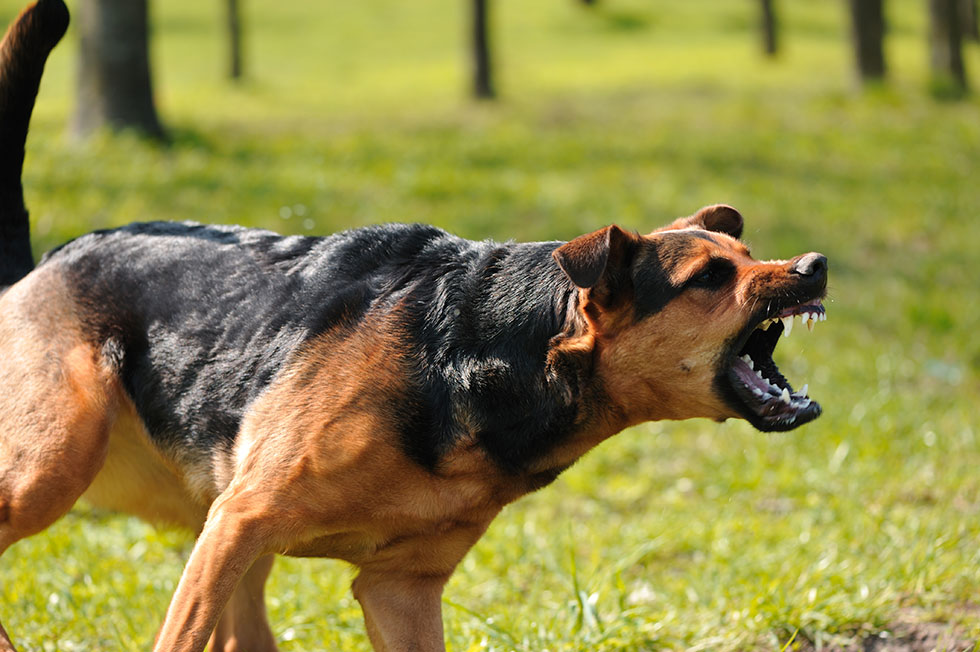Concerning Behaviour – Aggression
 October 1, 2019
October 1, 2019
Pets Training & Boarding examines aggressive behaviour in dogs, and the importance of understanding and resolving this type of response, in any dog, as quickly as possible.
Kirsten Lambros is a Senior Dog Handler from Pets Training & Boarding. When it comes to aggression Kirsten is quick to remind owners that it’s important to act quickly and that many dogs will not grow out of the problem, it will just become worst.
“There are many reasons for dogs to become aggressive,” Kirsten says. “The most common cases that I’ve dealt with has been dog aggression and people aggression.”
The main causes of this aggressive response?
“Dogs that are not well socialised as a puppy can become aggressive towards strangers, dogs, cats etc,” she says. “Another reason why dogs can show symptoms of aggression is due to negative experiences they have received, for example; being abused by children or people and worse – being attacked by another dog. It is to my belief that all dogs need to have positive encounters in all aspects of their lives to maintain a healthy balanced behaviour in their doggie years.”
When exhibiting symptoms of aggression your dog will generally act out of their normal characteristics such as; showing teeth, growling, not approaching, lunging towards people or dogs, becoming terrified and cowering when being handled.
Kirsten notes the following body signs to look out for that could signal that your dog is not feeling secure that can lead to an aggressive reaction.
- How your dog holds their tail, high, low, medium, tucked under?
- How your dog holds their ears, pricked and alert, relaxed, flat?
- How your dog displays their eyes, wide open, semi-closed, showing the whites of the eyes?
- Does your dog shake in a new environment?
- Does your dog do excessive lip licking?
- Does your dog pant excessively and it’s not a hot day?
“A lot of these behaviours are related to your dog being stressed and uncomfortable in different circumstances, your dog being uncomfortable can lead to fear-based aggression,” she warns.
Knowing these signs and understanding when your dog is feeling threatened or insecure can help alleviate the issue escalating.
What About Training?
A well-trained, well-mannered dog, is less likely to exhibit signs of fear-based aggression or aggressive tendencies. A dog that has a very strong communication bond with its owners (AKA training) is also less likely to feel threatened in situations, as their ‘leader’ (AKA you) has got the problem in hand.
Aggression cannot be trained out of a dog. However, a professional dog handler can help you understand your dog’s aggression and allow you to control this aspect of your pet.
“Our success rate solely relies on the hard work the owners wish to put in once their pet is collected from doggie boot camp,” she says. “However, we do offer a lifetime guarantee to assist clients throughout that particular lifetime if they have new problems or feel like they need further assistance in controlling their dog. We do all the hard work, but the owners need to ensure they keep it up.”
If you are struggling with your dog’s behaviour, you are not alone. Don’t be afraid to seek help and improve the bond you share with your dog, while reaping the rewards of well-behaved, and controlled, canine companion.
“All dogs who arrive into our care with aggression problems are handled with caution and care,” she says. “As we are a large boarding facility dog aggression can be catered to a lot easier as we have many breeds, ages, personalities in which we can socialise your aggressive pet.”
Aggression will not get better on its own, and more times than not will become worst. Once your dog realised this behaviour works – e.g. the other dog goes away, or the child backs off, it will just reinforce the behaviour. The quicker you seek help, the better.
